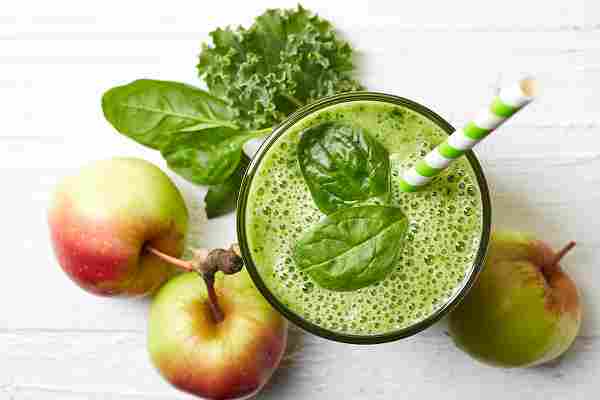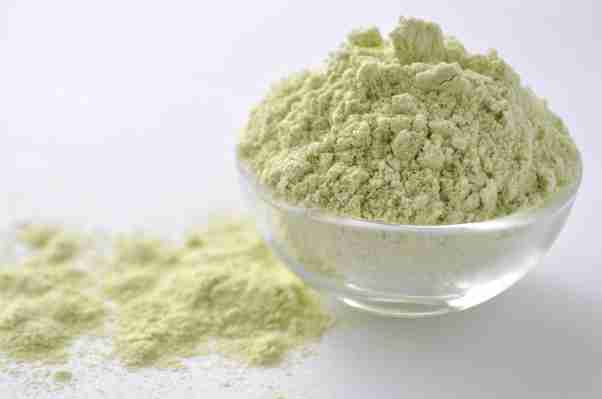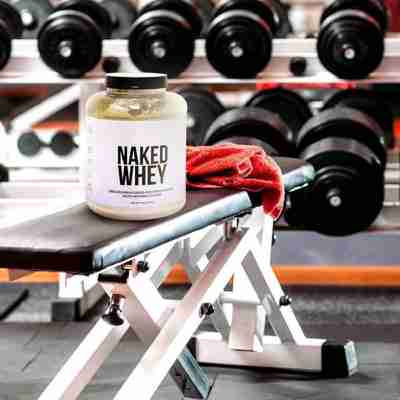Why I Don't Eat Protein Powder: To Fight Aging an Prevent Disease
The plant-based protein market was recently valued at $16.5 billion and is forecasted to triple, to $40.5 billion by 2025, with a myriad of varieties of vegan protein powder on the market. If you want to avoid soy, you have plenty of choices, whether you prefer pea- or rice- or hemp-based protein or some combination. If you don’t care for glyphosate in your powder, you can now choose from dozens of organic options.

However, as more and more consumers are coming to realize, billion-dollar industries don't always optimize their products for human health. Perhaps the most common question posed to vegans or people who eat plant-based has been, “Where do you get your protein?” The more apt question might be: Do you really need all that protein? There is growing evidence that a low-protein diet is healthier, helps fight aging, and prevents disease. And yet, we are sold on the hype that getting an abundance of protein is a requirement of a fit, active body, and the more the better.
The USDA dietary guidelines appear to have a fixation on protein—it's a food group—and since meat products contain some of the highest concentrations of protein per serving among all foods sold at grocery stores, the requirement for protein has proven an invaluable marketing tool. No matter whether you're selling plant-based products or those from animals, our obsession with protein intake has been a powerful marketing tool. Americans have been taught that protein helps build muscle. No protein, no strong bodies. But what if I told you that we don't need nearly as much protein as we've been told? And in fact, there are significant health benefits from getting less?
How protein works, and why too much can lead to aging, heart disease, and cancer
As for building strong muscles, one of the mechanisms in the body that facilitate this process is the hormone known as insulin-like growth factor 1(IGF-1), which is synthesized by the liver and muscles in higher quantities in people who eat more protein. Vegans, vegetarians, and flexitarians alike may rejoice that there are so many plant-based protein powders to help them raise their IGF-1 levels, but they may also be interested to learn about some of the unintended consequences of elevated IGF-1 levels.
Perhaps the most concerning studies are those that show elevated levels of IGF-1 have been associated with cardiovascular disease and cancer, which respectively are the first and second most common causes of death for Americans (cardiovascular disease alone kills over 650,000 Americans a year if you include heart attacks and strokes). The cancer study specifically states: "Epidemiological evidence is accumulating and suggests that the risk of cancers of the colon, pancreas, endometrium, breast, and prostate are related to circulating levels of insulin, IGF-1, or both."
The cardiovascular study states "Numerous studies have investigated the effect of serum IGF-I concentration on aging and different aging-related diseases, e.g. cardiovascular disease (CVD) and cancer. Decreased as well as increased levels have been reported to be associated with reduced life expectancy in humans." Essentially, too much protein as we age is as deadly as too little.
Accelerated aging and high protein consumption have been measured since 1996 when a study in the American Journal of Epidemiology showed that dietary protein increases calcium loss in the urine, putting high-protein consumers at risk of osteoporosis. The study found that women who ate more than five servings of red meat a week had a significantly higher risk of forearm fracture than women who ate less than one serving of meat a week. The study notes that an increased risk of bone fracture was not associated with higher consumption of vegetable protein (the study makes no mention of vegetable-derived protein powder), so it appears that protein consumption in the form of whole vegetable sources is healthiest.
In most cases, Americans eat far more protein than they need each day. The recommended daily amounts are 45 grams for a woman and 58 grams for a man, per day, though you can safely add more if you are actively training for an event or hitting the gym daily. Protein deficiency is not a serious problem in the American diet, whereas overeating is. (For a handy calculator, enter your age and weight and find out how much you need.)
Dr. Joel Fuhrman, bestselling author, doctor, and plant-based lifestyle champion, takes the position on IGF-1 is that to be your healthiest, you should maintain lower levels throughout your adult life by eating plant-based. In his blog on the topic, he writes:
"Excessively low or high IGF-1 levels could lead to health problems. In adults, a high IGF-1 level is linked to accelerated aging and an increased risk of cancer and premature death. Maintaining a relatively low IGF-1 level throughout most of one’s adult life is thought to be an important factor by which centenarians are able to live that long without developing cancer."
So what is the right amount? Furhman tackles that as well: "The European Prospective Investigation into Cancer and Nutrition (EPIC) study reported an average serum IGF-1 level of 200-210 ng/ml, suggesting that this is a typical level for adults on a Western diet. The amount of animal products consumed by most Americans drives their IGF-1 into this danger zone (above 200), increasing their risk of cancer."
Keeping your IGF-1 lower as you age is will minimize the risk of disease, including cancer, heart disease, and stroke, according to studies. To get the amount of protein you need (but not more) Dr. Furhman suggests you eat a varied plant-based diet incorporating more beans, greens, and seeds as you age to maintain healthy bone mass, muscle mass, and brain function.
Modern science has endowed us with the power to choose how high our IGF-1 hormone levels are and has also proven which choice–high protein or low protein–is associated with longevity. If you decide not to consume protein powder from any source, you may live longer than your gym buddy who takes it by the scoopful. You'll also save money on groceries.
Top 10 Sources of Plant-Based Protein According to a Nutritionist
Pea protein is everywhere, is it healthy?
Q: I’m suddenly seeing pea protein everywhere. What is it and is it healthy?

A: Pea protein is an extract from split peas, and food manufacturers are adding this protein to a variety of foods like energy bars, meal-replacement shakes, veggie burgers and even cereals. You can also find it as a powder to add when making smoothies.
With protein getting a lot of attention right now, pea protein offers a healthy option. Traditional approaches to boosting protein might have involved larger meat portions, yet evidence is strong that excess red and processed meats increase risk of cancer and other chronic diseases.
Growing interest in vegetarian and plant-based diets has likely prompted the increased availability of pea and other plant-based proteins. Pea protein also appeals to people who are lactose-intolerant or do not include dairy-based protein. But compared to getting protein from foods that bring a bevy of other valuable nutrients, it’s not the answer for everyone.
Growing interest in vegetarian and plant-based diets has likely prompted the increased availability of pea and other plant-based proteins.
Pea Protein versus Other Plant Proteins
Proteins are made of amino acids and there are nine amino acids that are essential in our diets. Unlike animal sources of protein, protein from plant foods is often low in one or more of these nine amino acids that makes a “complete” protein. Yet research shows that as long as you eat a variety of protein sources throughout the day, it’s not necessary to consume complete proteins in each meal.
Like the legumes from which it’s made, pea protein contains all the essential amino acids but it is low in one called methionine. That means it should be used as only one of many different protein sources, not the major choice throughout the day.
Pea protein is not all the same. Protein and other nutrient content varies based on the brand and whether it is a concentrate or isolate (isolates typically have more protein). Even when supplying equal amounts of protein, the amount of fiber differs. Some are a good source of fiber yet most contain little. This protein is relatively low in fat yet at least one that I looked at contained a concerning amount of trans fat (the type of fat most clearly damaging to heart health).
Compared to protein-fortified products with protein isolated from hemp seed, rice and most other grains, pea protein contains a better balance of essential amino acids.
Compared to protein-fortified products with protein isolated from hemp seed, rice and most other grains, pea protein contains a better balance of essential amino acids.
The less desirable aspect of pea protein is that it can have a gritty texture. So it seems to work best in smoothies with a variety of other ingredients, or in protein-enriched products using recipes that overcome that problem.
Pea Protein in the Big Picture
As a dietitian, I’m glad to see people thinking about ways to meet protein needs beyond big meat portions, and including protein in meals throughout the day. But it’s important to recognize that just because the grams of protein listed on a bar or drink look good, protein doesn’t turn a food lacking in nutrients into a healthy meal.
Consider what else you get from foods that supply protein. The standard size serving of pea protein powder as listed on labels often provides about 21 grams of protein. That’s the amount in about 3 ounces of meat, fish or poultry (the size of a deck of cards).
However, in extracting the protein, some of dry peas’ other nutrients may be removed. Split peas provide important amounts of magnesium, folate, and potassium, but labels provide no indication of how much is retained in pea protein powder. A serving of pea protein powder does often remain a good source of iron. But isolated pea protein also is missing the pea’s carbohydrate compounds that can support anti-inflammatory gut bacteria.
Foods that contain smaller amounts of protein can add up to meet your protein needs and provide other nutrients and phytochemicals. For example, blenderizing a smoothie with soy milk or tofu, or including a handful of nuts in a snack or mixed into salad also supplies magnesium, potassium, polyphenols, and vitamin E.
If you choose it to boost protein, just remember that whole foods provide more than protein: keep an eye on the big picture.
Bottom line
Pea protein can be a useful ingredient to provide structure to gluten-free foods or improve texture. If you choose it to boost protein, just remember that whole foods provide more than protein: keep an eye on the big picture of what your foods provide to promote overall health.
Karen Collins, MS, RDN, CDN, is AICR’s Nutrition Advisor. Karen is a speaker, writer and consultant who specializes in helping people make sense of nutrition news. You can follow her blog, Smart Bytes®, through her website and follow her on Twitter @KarenCollinsRD.
How Whey Protein Can Help Reduce Heart Disease
Whey protein is typically thought of as having a fairly limited scope of use. In the minds of most people, it's a way to build muscle. A smaller number realize the potential of whey to also help with weight-loss efforts. But, in truth, this is only a very small picture of all that whey has to offer.

Bundled up with all that protein, we find other oft-forgotten nutrients that can help to support numerous biological functions. Among these many under-appreciated uses, modern research has found that whey protein can help to reduce the risk of cardiovascular disease.
This term, though, is fairly broad and can have a number of involved factors and contributing symptoms. How, then, does whey protein help? What mechanisms does it use that can improve cardiovascular health?
Improved Blood Pressure
As mentioned, whey contains many other nutrients besides the titular protein – which generally get overlooked. For example, whey carries several peptides (amino acid pairings) that act as ACE-inhibitors.
A common class of blood pressure medication, substances in this category stop the product of an enzyme called angiotensin II which causes your blood vessels to narrow, placing stress on your heart and elevating your blood pressure.
A 2010 study published in the journal Obesity found that daily supplementation with whey protein was enough to significantly lower blood pressure and improve overall cardiovascular function in overweight and obese individuals.
Reduced Inflammation
Interestingly, that same study also found that whey had anti-inflammatory potential. What does this have to do with heart disease? Although it's a natural part of your body's defenses against numerous foreign threats, chronic or prolonged inflammation is not going to do you any favors. Depending on where the inflammation is, you might experience pain, soreness or any number of less obvious symptoms. This includes cardiovascular stress.
While the exact mechanisms aren't fully understood, experts do know that an inflammatory response causes atherosclerosis – the buildup of fat deposits on the walls of your arteries. This, in terns narrows the blood vessels, limit blood flow and can even lead to heart attack or stroke.
In addition to the ACE-inhibiting peptides that we just discussed, high doses of whey protein have been found to reduce levels of C-reactive protein (CRP), a marker for inflammation.
Improved Cholesterol
Right, so whey protein has the ability to protect your heart by preventing the inflammation that leads to fatty deposits blocking in your arteries and by generally widening those pathways. But, we aren't done yet.
Some research also suggests that whey protein – together with resistance exercise – can help to improve your overall cholesterol profile. On its own, whey seems to have the potential to increase levels of HDL (“good”) cholesterol. Resistance training, interestingly, can reduce LDL (“bad”) cholesterol. When they join forces, then, your cardiovascular health is protected from several angles.
steIt's also worth noting that whey is rich in L-Cysteine, an amino acid precursor for glutathione – a powerful antioxidant. Once active in your system, glutathione get to work fighting off stress and inflammation caused by free-radicals.

